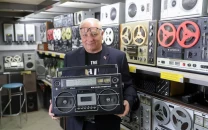Travelling tips: Music on the move
Touch screen technology, iPod spawns generation of music lovers unwilling to part with music players at any cost.

Travelling tips: Music on the move
Gone are the days when music enthusiasts had to carry their unwieldy boomboxes with them wherever they went. Touch screen technology and the compactness of the iPod has spawned a generation of music lovers unwilling to part with their music players at any cost. But while your favourite tunes can elevate your mood and energise you, the excessive use of earphones is not healthy.
Those hooked on to their portable music players need to use headphones/earphones with caution because the news of premature deafness in the future won’t be music to their ears. The fact that loud noises can cause hearing problems is hardly a new story. Many rock stars and other recording artists have exhibited symptoms of hearing loss, and some have blamed this on the aural damage caused by prolonged headphone use.
Short exposures to loud sounds may not cause too many problems. However, if you hear loud music on a daily basis, you should be wary of developing certain conditions. If symptoms like frequent ringing in the ear, difficulty in understanding speech and muffled sounds appear, an ENT (Ear, Nose and Throat) specialist’s appointment should be scheduled. Temporary deafness might be experienced, after a concert for instance, which indicates that the ears need a timeout.
But there are other lesser known conditions which can develop with prolonged earphone use. For instance, it can increase bacteria in the ear. This is particularly the case when headphones are being swapped, which is similar to people using the same cotton swab. Thus, people with a history of ear infections or those who are prone to them should restrict the use and sharing earphones.
But if you enjoy your music playlist on perpetual repeat mode, then there are a few safety measures you can take to minimise damage to your ears. While it is difficult to assess the right volume to play your music on, you should stick to 50-60 percent of the full volume and allow for periodic rests for the ears.
A change of headphones is an option, like the noise cancellation type, which dampens extraneous sound and permit lower volumes for a similar quality. These engulf the ear, but are often not preferred because they are heavy and bulky.
Moreover while music often serves as a good distraction in a noisy environment, this is not necessarily beneficial. We might be tempted to crank up the volume and drown out the rattling, rumbling and honking of automobiles and benefit from acoustic isolation, but to do this while walking or driving is a poor judgment call from the personal and public health viewpoint.
And helpful advice on a sidenote: ditch the iconic white Apple earbuds and stick to cheaper substitutes while sauntering in a dark alley…
Published in The Express Tribune, November 26th, 2011.



















COMMENTS
Comments are moderated and generally will be posted if they are on-topic and not abusive.
For more information, please see our Comments FAQ